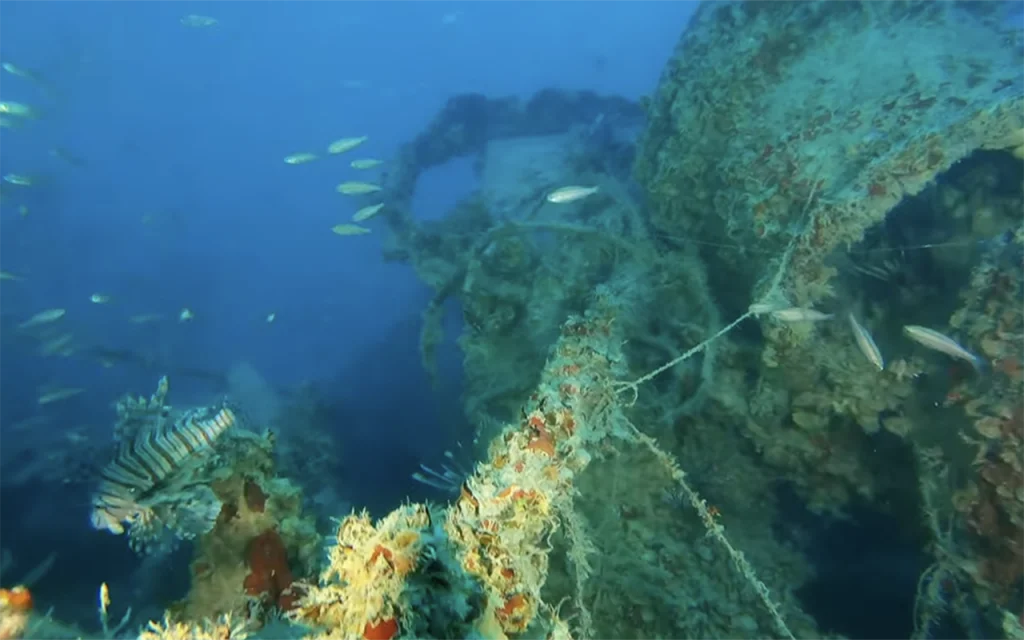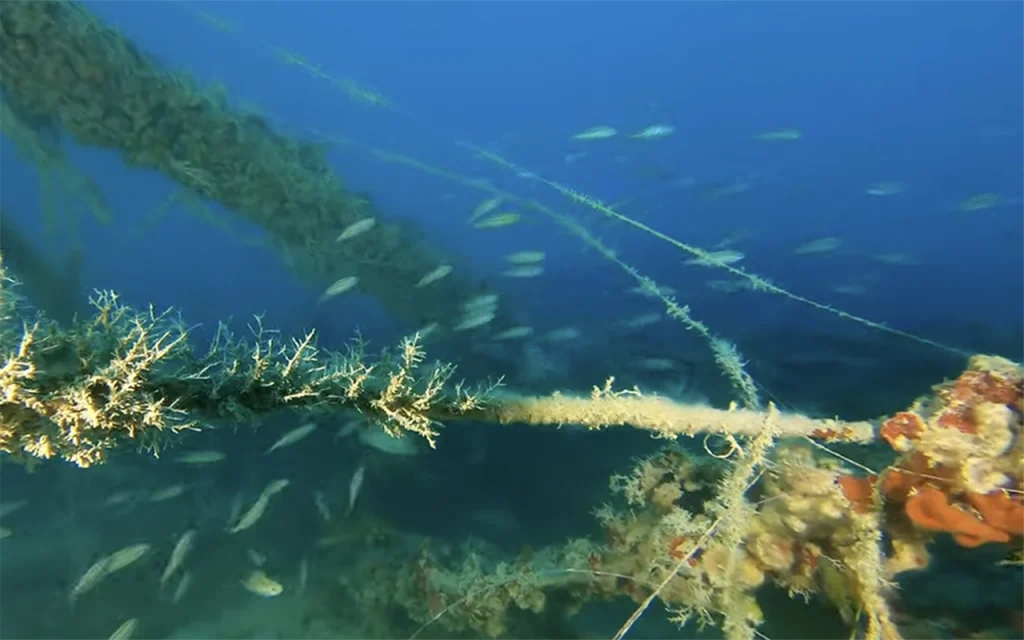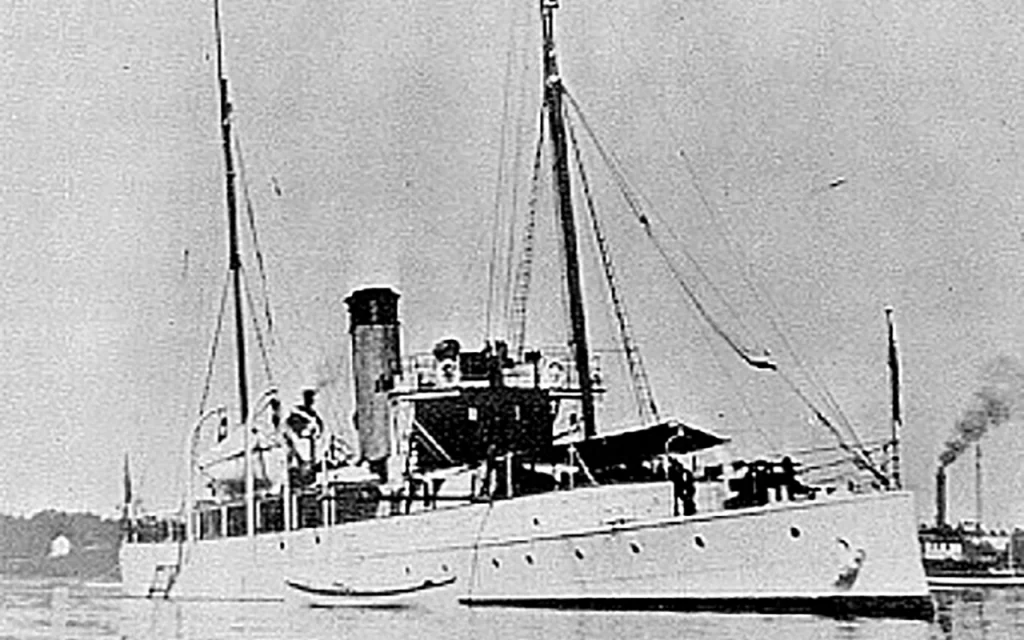Table of Contents

The Queen of Nassau’s journey from a Canadian government vessel to a shipwreck in the Florida Keys encapsulates a rich history of maritime service, transformation, and eventual demise.
Article at a Glance
- Historical Significance: Originally built in 1904 as CGS Canada, the Queen of Nassau served in the Canadian Fisheries Protection Service and the Royal Canadian Navy during World War I before becoming a passenger vessel.
- Wreck Location: The shipwreck is located approximately 3 miles off Alligator Light and 5 miles off Islamorada, Florida, at coordinates 24° 50.5′ N, 80° 37.5′ W, lying at a depth of 230 feet (70 meters).
- Unique Diving Experience: The wreck offers a technical diving challenge due to its depth, requiring specialized training and equipment, making it a sought-after site for experienced divers.
- Marine Life: The Queen of Nassau has transformed into an artificial reef, attracting a diverse range of marine life, including snapper, grouper, sharks, and sea turtles, enhancing the diving experience.
- Identifiable Features: Divers can explore the intact hull, ram bow, riveted steel construction, and various artifacts like china, which provide a tangible connection to the ship’s rich history.
- Safety Measures: Strict safety protocols are in place, including the requirement for technical diving certification, specialized equipment, and adherence to decompression obligations to ensure diver safety.
- Dive Shops Offering Trips: Several dive shops, including Conch Republic Divers, Sea Dwellers Dive Center, Key Dives, Florida Keys Dive Center, and Islamorada Dive Center, provide guided trips to the Queen of Nassau for qualified divers.
Shipwreck Location Coordinates and Depth
Depth
The wreck lies at a depth of about 230 feet (70 meters), making it a site suitable for technical diving due to its depth and the conditions around it.
Location & Coordinates
The coordinates for the wreck site are approximately 24° 50.5′ N, 80° 37.5′ W.

What Do Scuba Divers Say About This Ship
- Depth and Technical Challenge: The Queen of Nassau is situated at a depth of 230 feet, making it a deep technical dive that requires specialized training and equipment. This depth makes it one of the least dived yet most rewarding wrecks in the Florida Keys.
- Historical and Structural Significance: Originally built in 1904, the ship has significant historical value. Despite its age, the wreck remains relatively intact, allowing divers to explore its structure, including the collapsed mast and some damage to the stern. Artifacts such as china can still be found on the upper decks, offering a tangible connection to its past.
- Marine Life and Artificial Reef: The wreck has transformed into a thriving artificial reef, attracting a diverse range of marine life, including large fish like snapper, grouper, amberjack, sharks, and sea turtles. The depth allows for greater biodiversity compared to shallower sites.
- Challenging Conditions: Divers report that the fine sediment at the bottom and potential for strong currents add to the challenge, requiring careful buoyancy control and dive planning. The sediment can easily be disturbed, reducing visibility.
- Unique Diving Experience: Due to its depth and location, the wreck is not accessible to all divers, making it a special experience for those qualified to reach it. It is typically treated as a full-day dive due to its depth and distance from shore.
What Kind of Marine Life Can Be Found on The Ship
- Large Fish: The site is inhabited by large fish such as snapper, grouper, and amberjack.
- Sharks: Divers may encounter various types of sharks, including hammerheads and black tip sharks.
- Sea Turtles: These creatures are also part of the marine life that frequents the wreck.
- Invertebrates and Coral: The wreck has become an artificial reef, supporting the growth of oysters, coral, and sea sponges.
- Endangered Species: There have been sightings of endangered species such as the smalltooth sawfish and scalloped hammerhead sharks in the area.
Key Information
| Key Information | Details |
|---|---|
| Wreck Name | Queen of Nassau |
| Location | Florida Keys, approximately 3 miles off Alligator Light and 5 miles off Islamorada |
| Coordinates | 24° 50.5′ N, 80° 37.5′ W |
| Depth | Approximately 230 feet (70 meters) |
| Historical Background | Originally built in 1904 as CGS Canada; served in the Canadian Fisheries Protection Service and the Royal Canadian Navy during WWI. |
| Current Status | Lies intact under the water, serving as an artificial reef and popular dive site |
| Marine Life | Home to diverse species including snapper, grouper, sharks, and sea turtles |
| Diving Requirements | Technical diving certification required due to depth; specialized equipment recommended |
| Dive Shops Offering Trips | Various shops in the Florida Keys provide guided dives to the wreck |
What Makes Queen of Nassau a Unique Diving Experience
- Depth and Technical Challenge: The wreck is located at a depth of 230 feet (70 meters), making it a deep technical dive that requires specialized training and equipment. This depth makes it one of the least dived but most rewarding wrecks in the Florida Keys.
- Historical Significance: Originally built in 1904 as CGS Canada, the ship played a significant role in Canadian maritime history before being repurposed as a cruise ship. Its historical background adds intrigue to the dive.
- Intact Structure and Artifacts: Despite its age, the wreck remains relatively intact, allowing divers to explore its structure. Artifacts such as china can still be found on the upper decks, providing a tangible connection to the ship’s past.
- Marine Life and Artificial Reef: The wreck has transformed into a thriving artificial reef, attracting a diverse range of marine life, including large fish like snapper, grouper, amberjack, sharks, and sea turtles. The depth allows for greater biodiversity compared to shallower sites.
- Challenging Conditions: The site presents challenging conditions with fine sediment at the bottom and potential for strong currents, requiring careful buoyancy control and dive planning. These factors add to the uniqueness and difficulty of the dive.
- Limited Access and Full-Day Experience: Due to its depth and location, the wreck is not accessible to all divers, making each dive a special experience for those qualified to reach it. It is typically treated as a full-day dive due to its depth and distance from shore, offering a more immersive and dedicated diving experience.
How Does The Queen of Nassau Compare to Other Shipwrecks in Florida
- Depth and Technical Challenge: The Queen of Nassau is located at a depth of 230 feet, making it a technical dive that requires specialized training and equipment. This depth makes it one of the least dived wrecks in the Florida Keys, adding to its allure for experienced divers seeking a challenging dive.
- Historical Significance: Originally built in 1904 as CGS Canada, the ship has a rich history, having served in the Canadian Fisheries Protection Service and the Royal Canadian Navy during World War I. Its transformation into the Queen of Nassau and eventual sinking in 1926 adds historical intrigue, setting it apart from other wrecks in the region.
- Intact Structure and Artifacts: Despite its age, the wreck remains relatively intact, allowing divers to explore its structure and discover artifacts such as china on the upper decks. This level of preservation is not always found in other shipwrecks.
- Marine Life and Artificial Reef: The wreck has become a thriving artificial reef, attracting a diverse range of marine life, including large fish like snapper, grouper, amberjack, sharks, and sea turtles. This biodiversity is enhanced by the wreck’s depth, which supports a greater variety of marine species compared to shallower sites.
- Challenging Conditions: The presence of fine sediment and potential for strong currents adds to the challenge of diving the Queen of Nassau, requiring careful buoyancy control and dive planning. These conditions make it a unique experience compared to other, more accessible wrecks.
What is The Full History of This Ship
Construction and Early Service
- Built in 1904: The ship was constructed by Vickers Sons and Maxim Ltd. in Barrow-in-Furness, England. It was a 200-foot-long, steel-hulled steamship, and the first armed vessel owned by the Canadian government.
- Canadian Fisheries Protection Service: Initially, it served as a fisheries protection cruiser, safeguarding Canada’s fishing interests against foreign intrusions. It was considered the fastest vessel in the Canadian Fisheries Protection Service, capable of speeds up to 22 knots.
World War I Service
- HMCS Canada: During World War I, the ship was rechristened as HMCS Canada and served in the Royal Canadian Navy. It was used for mine surveying and protecting troop convoys headed to England.
Post-War and Sale
- Return to Fisheries Service: After the war, the ship returned to the Canadian Fisheries Protection Service until it was decommissioned in 1919.
- Sale and Renaming: In 1924, the ship was sold to Barron Collier, a Florida land developer, who renamed it the Queen of Nassau. Collier intended to convert it into a passenger vessel for service between Miami and Nassau, Bahamas, but the ship was not suitable for luxury passenger service.
Final Voyage and Sinking
- Decrepit Condition: The ship was left docked in Biscayne Bay for 18 months with minimal maintenance, leading to its deterioration.
- Sinking Incident: On July 2, 1926, while en route from Miami to Tampa for a final inspection before being sold to a Mexican buyer, the ship began taking on water due to a leak. Despite efforts to repair it, the ship was abandoned by its crew and sank off Islamorada, Florida.
Discovery and Current Status
- Wreck Discovery: The wreck was discovered in 2001 by divers from the Association of Underwater Explorers. It lies in 230 feet of water and remains relatively intact, with a significant amount of marine life and artifacts.
- Diving Site: Today, the Queen of Nassau is a popular technical diving site, known for its historical significance and rich marine biodiversity.

What Historical Features Can Still Be Identified on The Queen of Nassau Wreck
- Intact Hull: The hull of the Queen of Nassau is completely intact, with no visible breaks or damage. This preservation allows divers to explore the ship’s structure extensively.
- Ram Bow: One of the distinctive historical features is the vessel’s ram bow, which is plumb at deck level and juts sharply forward as it nears the keel. This characteristic is indicative of early 20th-century steel warships.
- Riveted Steel Construction: The ship’s riveted steel construction is another historical feature that points to its origins as a warship. This construction method was common in ships built during the early 1900s.
- Artifacts: Divers have found various artifacts on the wreck, including china on the upper decks. These artifacts provide a tangible connection to the ship’s past and its use as a passenger steamer.
- Structural Features: Despite some damage to the stern and running gear, the ship remains relatively intact. The wood decks have eroded, and sediment has accumulated in the lower areas, but these conditions also preserve the historical essence of the wreck.
- Debris Field: The debris field surrounding the wreck includes items that slid off the ship when it sank. This field offers additional insights into the ship’s final moments and its historical context.
What Safety Measures Are in Place for Divers Visiting The Queen of Nassau
- Technical Diving Certification Required: Divers must possess technical diving certification because the wreck is located at a depth of 230 feet (70 meters), which classifies it as a technical dive.
- Specialized Equipment: Divers are advised to use dry suits, heavier gloves, and hoods to maintain warmth at this depth. Additionally, mixed gases such as nitrox or trimix are necessary to manage decompression obligations.
- Redundant Air Sources: The use of redundant air sources, rebreathers, and other technical diving gear is essential to ensure safety during the dive.
- Decompression Obligations: The dive requires significant decompression time on the ascent, often around 10 minutes, necessitating careful dive planning and adherence to decompression schedules.
- Environmental Conditions: Divers must be prepared for open water conditions that can include strong currents and reduced visibility due to sediment. Excellent buoyancy control is necessary to avoid disturbing the seafloor and maintaining visibility.
- Dive Planning and Support: Dives to the Queen of Nassau are typically treated as full-day excursions. It is recommended to dive with experienced operators who can provide necessary support and logistics, including monitoring weather and current conditions.
- Regulatory Oversight: The wreck is located within the Florida Keys National Marine Sanctuary and is subject to regulations and oversight by NOAA. Divers must comply with all applicable rules and guidelines for exploring this protected site.
Dive Shops That Prove Diving Trips to This Shipwreck
- Conch Republic Divers: Based in Tavernier, Florida, this dive shop provides guided trips to the Queen of Nassau and other deep wrecks in the Keys.
- Sea Dwellers Dive Center: Located in Key Largo, Florida, this dive center is known for offering technical diving trips to the Queen of Nassau wreck.
- Key Dives: Situated in Islamorada, Florida, Key Dives offers access to the Queen of Nassau and other notable wreck diving sites in the area.
- Florida Keys Dive Center: Also located in Islamorada, this dive center caters to technical divers interested in exploring the Queen of Nassau.
- Islamorada Dive Center: This dive center specializes in technical diving and can arrange trips to the Queen of Nassau wreck.





